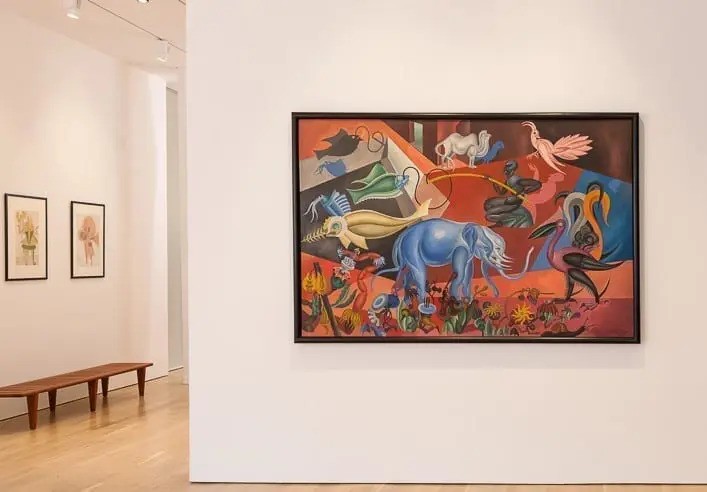|
Getting your Trinity Audio player ready...
|
Edited by: Fern Sidman
New York City’s small museums, which have long been a cornerstone of its vibrant artistic landscape, are facing unprecedented challenges. Economic pressures, exacerbated by the pandemic, are forcing many to move, reinvent themselves, or close their doors entirely, according to a report that appeared on Friday in The New York Times. These institutions, integral to the city’s cultural fabric, are now navigating a difficult path to survival.
Last week marked the end of an era for the Center for Italian Modern Art (CIMA) in Manhattan’s SoHo neighborhood. As was reported by the NYT, after more than a decade of celebrating Italian modern art, CIMA announced it would cease operations and seek a university to take over its archive. Founder Laura Mattioli highlighted the financial difficulties that led to this decision.
“We were open for about 11 years, but the situation has changed since the pandemic,” Mattioli explained to the NYT. The pandemic not only reduced visitor numbers but also made the logistics of transporting artworks from Italy prohibitively expensive. “We sometimes spent more on the travel of artworks to and from Italy than the actual value of the artworks themselves,” she noted.
In May, Fotografiska New York, an offshoot of the global photography museum located in Gramercy Park, also faced a harsh reality. The museum announced it was seeking a new home and laid off several employees, citing economic reasons for its closure, according to the information provided in the NYT report. The decision underscored the financial instability many cultural institutions are grappling with, even as they attempt to remain relevant and accessible.
The Rubin Museum of Art, known for its Himalayan and Indian art collections, declared in January that it would sell its Chelsea building and reduce its staff by 40 percent, the report in the NYT affirmed. This move is part of a strategic shift towards focusing on traveling exhibitions and long-term loans to other institutions. The museum aims to “redefine what a museum can be” in response to the evolving cultural landscape.
The struggles of these institutions are not isolated incidents. Early in the pandemic, a survey by the American Alliance of Museums (AAM) warned that up to one-third of cultural institutions in the United States might close without significant support from governments and private donors, as per the information in the NYT report. While the worst-case scenario did not materialize, largely due to federal loans and eased restrictions on accessing endowments or selling artworks, many museums remain on precarious financial footing.
To bridge the financial gap, numerous institutions have raised entry fees. However, this is a double-edged sword, as higher prices can deter visitors, further compounding financial difficulties.
The fate of small museums in New York City highlights the broader challenges facing the cultural sector. These institutions must balance the preservation and promotion of art with the harsh realities of economic sustainability. For many, this means rethinking traditional models and exploring innovative approaches to engage audiences and secure funding.
During the early days of the pandemic, many museums managed to stay afloat through federal loans, loosened restrictions on endowments, and increased entry fees. However, these measures may have only delayed the inevitable financial reckoning. The NYT reported that over the past few years, attendance levels have not rebounded to pre-pandemic levels, and fundraising efforts have slowed significantly. Meanwhile, overhead costs and employee salaries continue to rise, adding to the financial strain.
To cope, many museums have reduced the number of exhibitions they host each year in an effort to cut costs. This belt-tightening approach has had mixed results, often leading to diminished public engagement and further financial challenges.
The financial difficulties faced by museums were not solely a product of the pandemic. Erika Sanger, who recently ended her tenure leading the Museum Association of New York, noted that a significant portion of New York’s museums entered the pandemic already operating at a deficit. “The expectation that museums have a lot of money is not true for everyone. Smaller and medium-sized institutions have trouble sustaining themselves,” Sanger told the NYT. This preexisting vulnerability has only been exacerbated by recent economic challenges.
Recognizing the dire situation, cultural institutions have been vocal in their calls for increased funding. In January, arts executives sent a letter to city officials urging the restoration of $53 million in proposed arts funding cuts, as was indicated in the NYT report. They argued that cutting arts funding, which constitutes only a small fraction of the city’s budget, would be “penny-wise and foolish.”
In a positive turn, Mayor Eric Adams announced that the upcoming budget would fully restore funds to both libraries and cultural institutions. “These institutions are a critical part of New York City’s social fabric,” Adams said in a statement, as was noted in the NYT report.
Despite the restoration of funds, the financial reality for many museums remains grim. Adrian Benepe, president and chief executive of the Brooklyn Botanic Garden, expressed relief but also highlighted the ongoing challenges. “All of us are getting about the same funding from the city we got 15 years ago,” he explained while speaking with the NYT. Over that period, inflation has driven up costs significantly, while the proportion of operating revenue covered by the city has decreased from 30 percent to 10 percent.
In recent years, New York lawmakers have taken steps to understand and bolster the state’s cultural institutions. Last year, they appropriated $1 million to commission a report on the economic and social contributions of these institutions, the NYT report said. This initiative aims to provide a comprehensive understanding of their value and inform future support strategies.
Additionally, the state has approved significant funding for specific museums. Recently, legislators allocated $10 million to the Museum of Innovation and Science in Schenectady. This funding will help the museum, which houses General Electric’s archives, remain operational and address its deteriorating infrastructure, the information in the NYT report indicated. Such targeted support is crucial for preserving the heritage and educational resources that these museums offer.
Despite these efforts, many smaller museums continue to face insurmountable challenges. Laura Mattioli, founder of the Center for Italian Modern Art (CIMA), highlighted the difficulties her institution faced in securing grants. She noted that changes in grant-making organizations’ criteria, particularly after the pandemic and the Black Lives Matter movement, have made it harder for her museum to compete for funding.
“Many grant-making organizations now require exhibition proposals to include elements of diversity and inclusion,” Mattioli explained to the NYT. “Themes of social justice are more prevalent in American art than in modern Italian art, making it difficult for our museum to compete for funding.”
Mattioli also pointed to shifting visitor habits as a significant factor in CIMA’s closure. “Would I open CIMA today? I think not,” she said, a was reported by the NYT. “We are closing because there is a change in the way a young person sees artworks compared to people from my generation.”
Michele H. Bogart, an art historian at Stony Brook University, contextualized the struggles of small museums within the broader lifecycle of arts organizations. When speaking with the NYT, she cited the example of the Center for Brooklyn History merging with the Brooklyn Public Library system in 2020 as a common outcome for smaller institutions.
“There is something that gets lost,” Bogart told the NYT. “All of them contribute in some way to the vitality of the city and offer jobs.” However, she warned that during economic downturns, the fragile nature of these institutions means they can easily disappear.




